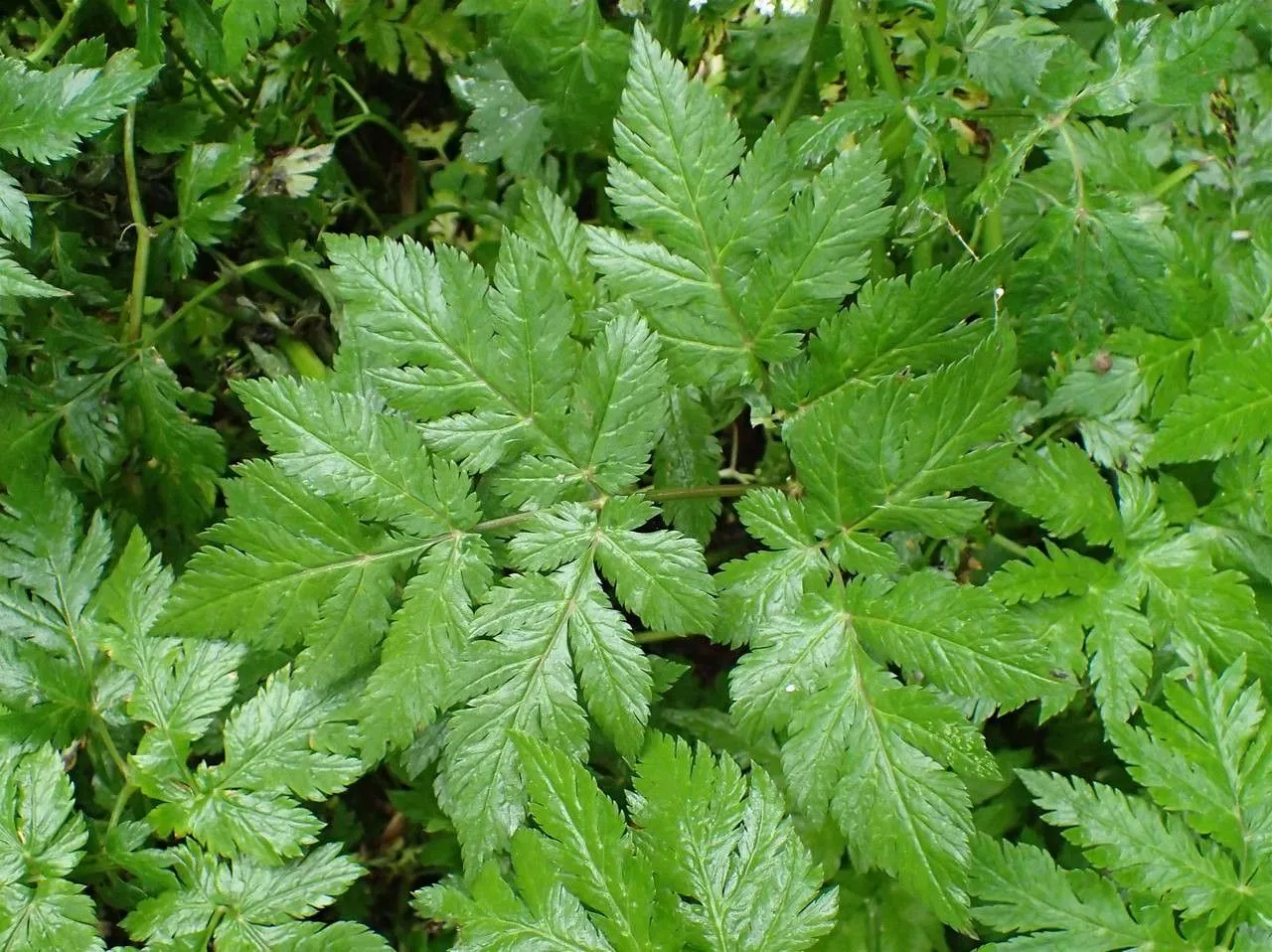
Author: L.
Bibliography: Sp. pl. 1:258. 1753
Year: 1753
Status: accepted
Rank: species
Genus: Chaerophyllum
Vegetable: False
Observations: C. & S. Europe to NW. Caucasus
Hairy chervil, scientifically designated as Chaerophyllum hirsutum, is an intriguing member of the Apiaceae family. This plant carries historical significance, having been first described by the esteemed botanist Carl Linnaeus in his seminal work “Species Plantarum,” published in 1753.
Native to a diverse geographic range, the hairy chervil is found spanning from Central and Southern Europe to the Northwestern Caucasus. This wide distribution testifies to the plant’s adaptability to various climatic conditions and terrains.
Characterized by its finely dissected leaves and delicate umbels of small white flowers, the hairy chervil can often be distinguished by its slightly hairy stems and foliage, which give the plant its common name. The overall appearance of the plant is graceful and reminiscent of other members of its family, such as the wild and garden chervils, yet it maintains its unique characteristics that enthusiasts and botanists alike cherish.
The plant thrives in well-drained soils, often found in woodland areas and forest edges where it can enjoy partial shade. It plays a vital role in its ecosystem, offering nectar and pollen to a range of pollinating insects, thus contributing to the biodiversity of its native regions.
Hairy chervil is not only significant ecologically but also holds potential value in horticulture due to its aesthetic foliage and floral display. Its delicate fern-like leaves can add a touch of elegance to herbaceous borders and naturalistic planting schemes, making it a preferred choice for garden enthusiasts aiming to create a more natural and biodiverse garden environment.
In conclusion, Chaerophyllum hirsutum is a plant of remarkable beauty and ecological importance, providing a link between human appreciation and natural biodiversity. Its historical and horticultural relevance continues to intrigue and inspire further study and cultivation among plant lovers and professionals alike.
Dan: bjerg-hulsvøb, håret hulsvøb
Eng: hairy chervil
Deu: rauhaariger kälberkropf, rauhaariger-kälberkropf, wimper-k., rauhhaariger kälberkropf
Swe: bergkörvel
Nno: alpekjeks
Nob: alpekjeks
Cym: gorthyfail blewog, perllys blewog
En: Hairy chervil
Ar: سرفل أهلب
Be: Цьмянец цыкутавы
Bg: Влакнест балдаран
Ca: Cominassa hirsuta
Cs: Krabilice chlupatá
Da: Bjerg-hulsvøb, Håret hulsvøb
Nl: Borstelig Ribzaad
Fi: Karvakirveli
Fr: Cerfeuil hirsute, Cerfeuil dressé, Chérophylle hérissé, Cerfeuil hérissé
De: Rauhaariger Kälberkropf, Rauhaariger-Kälberkropf, Wimper-K., Rauhhaariger Kälberkropf, Behaarter Kälberkropf, Berg-Kälberkropf, Gebirgs-Kälberkropf
Hu: Szőrös baraboly
It: Cerfoglio selvatico, Cerfoglio irsuto, Scandia pelosa
Lt: Plaukuotasis gurgždis
Nb: Alpekjeks
Nn: Alpekjeks
Pl: Świerząbek orzęsiony
Sv: Bergkörvel
Cy: Gorthyfail blewog, Perllys Blewog
Taken Jun 1, 2020 by Severine B (cc-by-sa)
Taken Jun 4, 2017 by Yoan MARTIN (cc-by-sa)
Taken Jul 14, 2022 by Blue Bottle (cc-by-sa)
Taken Oct 8, 2021 by Gerrit Busser (cc-by-sa)
Taken Oct 21, 2022 by Sophie Angerer (cc-by-sa)
Taken Jun 1, 2020 by Severine B (cc-by-sa)
Taken May 23, 2021 by Mallol Camprubí Albert (cc-by-sa)
Taken Jun 1, 2020 by Severine B (cc-by-sa)
Taken May 4, 2022 by anna maria molino (cc-by-sa)
Taken Jun 7, 2021 by Gloria (cc-by-sa)
Taken Jun 4, 2017 by Yoan MARTIN (cc-by-sa)
Taken Jun 14, 2012 by Tela Botanica − Hugues TINGUY (cc-by-sa)
Taken Mar 27, 2013 by Tela Botanica − Alain LÉTRANGE (cc-by-sa)
Taken Mar 27, 2013 by Tela Botanica − Alain LÉTRANGE (cc-by-sa)
Taken May 7, 2016 by Tela Botanica − Yoan MARTIN (cc-by-sa)
Taken Jul 6, 2010 by Tela Botanica − Marie PORTAS (cc-by-sa)
Taken Jun 14, 2014 by Tela Botanica − Liliane Roubaudi (cc-by-sa)
Taken Jun 14, 2014 by Tela Botanica − Liliane Roubaudi (cc-by-sa)
Taken Aug 20, 2020 by cirse (cc-by-sa)
Taken Jun 4, 2017 by Yoan MARTIN (cc-by-sa)
Taken May 23, 2021 by Inge Patsch (cc-by-sa)
Taken Aug 20, 2020 by cirse (cc-by-sa)
Taken Jun 4, 2017 by Yoan MARTIN (cc-by-sa)
Taken Jun 4, 2017 by Yoan MARTIN (cc-by-sa)
Taken Jun 4, 2017 by Yoan MARTIN (cc-by-sa)
Taken Jan 1, 1970 by Photoflora – L’Abbé COSTE (©)
Taken Jul 15, 2011 by Photoflora – Benoit BOCK (©)
Taken Jul 15, 2019 by Photoflora – Jean-Luc TASSET (©)
Taken Mar 27, 2013 by Tela Botanica − Alain LÉTRANGE (cc-by-sa)
Taken Jul 21, 2021 by Karen Vorberg (cc-by-sa)
© copyright of the Board of Trustees of the Royal Botanic Gardens, Kew.
© copyright of the Board of Trustees of the Royal Botanic Gardens, Kew.
© copyright of the Board of Trustees of the Royal Botanic Gardens, Kew.
Ph maximum: 7.5
Ph minimum: 7.0
Light: 8
Atmospheric humidity: 7
Soil nutriments: 8
Family: Myrtaceae Author: (F.Muell.) K.D.Hill & L.A.S.Johnson Bibliography: Telopea 6: 402 (1995) Year: 1995 Status:…
Family: Rubiaceae Author: Pierre ex A.Froehner Bibliography: Notizbl. Bot. Gart. Berlin-Dahlem 1: 237 (1897) Year:…
Family: Sapindaceae Author: Koidz. Bibliography: J. Coll. Sci. Imp. Univ. Tokyo 32(1): 38 (1911) Year:…
Family: Asteraceae Author: A.Gray Bibliography: Pacif. Railr. Rep.: 107 (1857) Year: 1857 Status: accepted Rank:…
Family: Fabaceae Author: Medik. Bibliography: Vorles. Churpfälz. Phys.-Ökon. Ges. 2: 398 (1787) Year: 1787 Status:…
Family: Aspleniaceae Author: (Cav.) Alston Bibliography: Bull. Misc. Inform. Kew 1932: 309 (1932) Year: 1932…